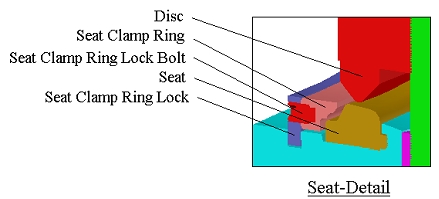| |
 |
|
|
|
 |
|
|
|
|
|
 |
|
|
|
|
|
 |
|
|
|
|
|
 |
 |
 |
 |
 |
|
 |
 |
 |
|
|
|
|
|
 |
|
|
|
|
|
 |
 Controlled Closure Check Valve .
Controlled Closure Check Valve .
|
 |

 |
| |
| |
| |
| |
| |
| |
| |
| |
| |
| |
| |
| |
| |
| |
| |
| |
| |
|
| |
1.Function |
| |
The Controlled Closure Check Valve
was developed and qualified to serve a function to control the |
| |
valve closing velocity.If a
feed-water line should rupture in a nuclear power plant, the reversed |
| |
flow from the steam generator out of
the containment boundary must be contained. |
| |
Swing check valve would close
rapidly, but not fast enough to prevent high reverse flow velocity;
|
| |
closure of the swing check valve
would produce severe pressure surges due to water hammer - |
| |
possibly severe pressure enough to
produce rupture of other piping or equipment. |
| |
|
| |
The Controlled Closure Check Valve is
similar to Y-pattern Lift check vavle, but it has an |
| |
integral "dash-pot" - a battle plate
with a close-clearance fit around the rod connecting the disc |
| |
and piston. Flow paths sized for and
consequently control the valve closing speed. |
| |
|
| |
2. Characteristics |
 |
- Minimizes water hammer effects on
postulated feed-water line break. |
|
- Computerized modeling verified by
dynamic testing. |
| |
|
|
|
|
| |
|
|
|
|
| |
|
|
|
|
|
| |
|
|
|
|
|
| |
|
|
|
|
|
| |
|
|
|
|
|
| |
|
|
|
|
|
| |
|
|
|
|
|
| |
 |
|
|
|
 |
|
|
|
|
|
 |
|
|
|
|
|
 |
|
|
|
|
|
 |
 |
 |
 |
 |
|
 |
 |
 |
|
|
|
|
|
 |
|
|
|
|
|
 |
 Butterfly Valve for Nuclear Power Plant.
Butterfly Valve for Nuclear Power Plant.
|
 |

 |
| |
| |
| |
| |
| |
| |
| |
| |
| |
| |
| |
| |
| |
| |
| |
| |
| |
|
| |
1.Design characteristics |
| |
- Valve Size : 2" through 48" |
| |
- Valve Rating : Class 150 |
| |
- Application Code : ASEM B16.34 &
ASME Sec. Ⅲ |
| |
- Seismic Rating : Category
Ⅰfor active and
non-active service. The upset emergency or faulted |
| |
conditions
will be analyzed concurrently with 5g seismic load applied simultaneously
along three |
| |
major axes. The stress levels code
allowable. |
| |
- Qualification : Performed
functional qualification test per ASME QME-1 |
| |
|
| |
2.Seat Characteristics |
| |
- Sealing is achieve by elastically
deforming the seat. |
| |
- Seat design offers the advantage of
being easily replaceable in the field. |
| |
- Mechanically retained on the disc ;
adjustable with access from flanged end of the valve |
| |
 |
| |
| |
| |
| |
| |
| |
 |
| |
|
| |
|
| |
|
| |
|
| |
|
| |
|
|
|
|
|
| |
|
|
|
|
|
| |
|
|
|
|
|




















